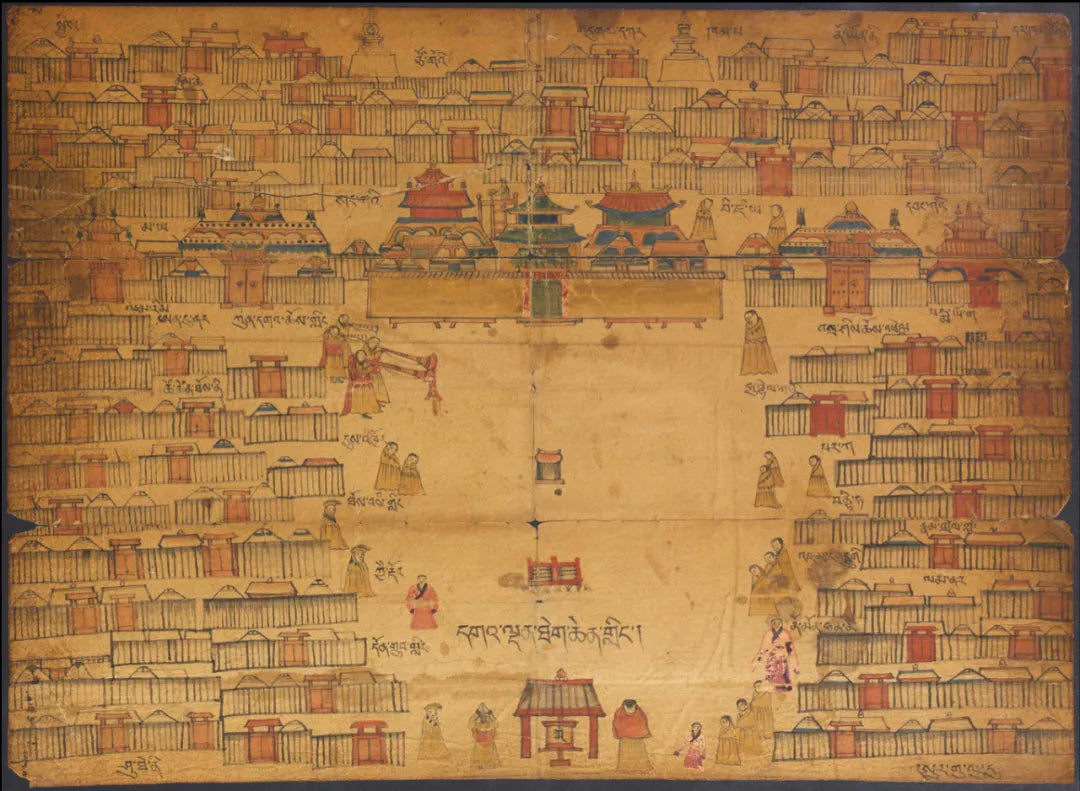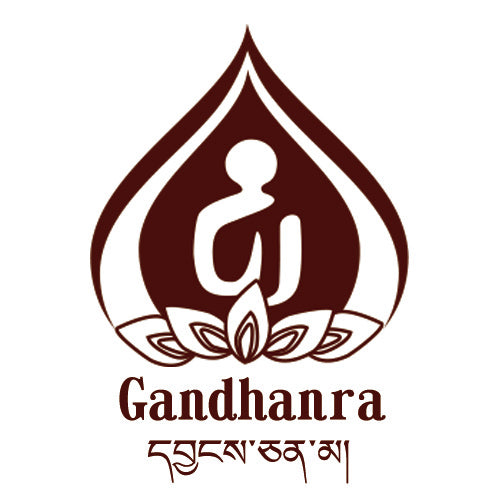
Hidden temples in the hinterland of North Asia: the Gandan Monastery complex in Ulaanbaatar

Collected by Mr. and Mrs. Ernst in the late 19th century

(དགའ་ལྡན་ཐེག་ཆེན་གླིང་ - Ganden Monastery)

The beautiful land resembles the vast sky,
The monastery resembles the rising sun and moon,
The multitude of tents resembles shining stars,
Who can boast witnessing such a marvelous scene?
(...)
The essence of wisdom is preached in this place,
As if transported from the snowy plateau,
The essence of the Ganges' vast lands
Slowly flows into the Fish King's city.
* "Zagu girl" refers to the Ganges
"Fish King City" refers to the ocean
Excerpt from "Brief Description of Ganden Monastery Praise Text"
Written by the Northern Gelug scholar Losang Dendzin
His representative works include "History of Mongolian Buddhism"



"Portraits of Eighty-Four Great Accomplished Masters in Gan Dan Monastery Collection," 19th century
Under the skillful pen of Losangdanjin, also known as "Kāruka Manjushri", the Gandantegchinlen Monastery in Ulaanbaatar possesses the same sacred lineage and wisdom blessings as its mother monastery Gandan Monastery, and this concept has deepened over the centuries through the continuous restoration efforts of the Jebtsundamba Khutughtu in Mongolia. For the Thirteenth Jebtsundamba Khutughtu (1876-1933), who sought refuge from the British forces in 1904-1905, Gandan Monastery served as a sanctuary in the north.
In the Dekyi Tsonkhang Palace within Gandan Monastery (originally the Winter Palace of the Fifth Jebtsundamba Khutughtu / built between 1838 and 1840), the Thirteenth Jebtsundamba Khutughtu was able to temporarily escape his predicament and contemplate the future development path of Tibet. To commemorate this special experience, upon his return to Lhasa, the Thirteenth Jebtsundamba Khutughtu requested officials to set up several Mongolian yurts in the Norbulingka Summer Palace, creating a complex of red and yellow monasteries and white tents that became a memorable sacred site in his life (as the Thirteenth Jebtsundamba Khutughtu preferred to meet pilgrims from Gandan Monastery).
"This place (Gandan Monastery) is the educational center in the city," wrote a Russian explorer who visited the city of Kuren (modern Ulaanbaatar), "It is considered the abode of pure morality and supreme power." It is worth noting that the term "Kuren" does not refer to a specific place originally; instead, it denotes a settlement form unique to the nomadic peoples of inland Asia, centered around a specific building and surrounded by movable tents with various functions. The First Jebtsundamba Khutughtu established the Great Kuren in 1639; by the mid-eighteenth century, the Great Kuren had become the political, economic, and cultural center of outer Mongolia, eventually evolving into the modern-day Ulaanbaatar known to us.
The Great Kuren can be roughly divided into three parts: the nomadic Eastern Kuren, the monastery Western Kuren, and the Chinese trading town in the southeast. Unlike the urban layout we are familiar with, the Great Kuren has no city walls; fences and low walls are the only boundaries separating spaces. The monastery Western Kuren, with Gandan Monastery at its core, has strict management regulations (such as rules for visits from the opposite sex), most of which are derived from the monasteries in Tibet like Drepung and Sera.

"Panoramic View of the Capital City of Daqurun, Completed in 1912
Drawn by the North Asian scholar Jügder"

The Western Complex of monasteries, primarily including Gandan Monastery.

"The Fourth Zhabu Zuntanba"
Early 20th century, collected by Zhanaba Zalmei Art Museum

Late 19th century, Zanabazar Fine Art Museum collection.

2- Gongga Quelin Monastery(ཀུན་དགའ་ཆོས་གླིང་གྲྭ་ཚང་)
3- Central Great Hall and Palace(ཚོགས་ཆེན་)
4- Zaxi Qubei Monastery(བཀྲ་ཤིས་ཆོས་འཕེལ་གྲྭ་ཚང་)
5- Lotus Yoga Retreat(གནས་ཆེན་པད་མ་ཡོ་ག་)
According to Mongolian scholars, by the mid-late 19th century, there were around two thousand resident monks at the Gaden Monastery, with countless Buddhist scholars graduating from the monastery. Lhasa regularly sent high-ranking monks from the three main monasteries to serve as abbots or masters at the Gaden Monastery, including the student of the 13th Dalai Lama and the 9th Panchen Lama, the "Omnipresent Buddhist Administrator" Losang Thubten Jigmepel Gyaltsen (ལྷ་བཙུན་བློ་བཟང་ཐུབ་བསྟན་དགེ་ལེགས་རབ་རྒྱས་;1883-1967).
The architecture of the Gaden Monastery reflects a blend of Mongolian, Tibetan, and Chinese styles (some buildings exhibit elements of Yuan architecture), and the daily rituals at the monastery provide a glimpse of the historical imprint of the fusion of Mongolian and Tibetan cultures. The central hall of the Gaden Monastery was constructed in 1839, and according to existing Mongolian documents, many of the daily rituals in the central hall were derived from the Jokhang Monastery in Lhasa, but scholars from North Asia added many segments related to the prohibition of alcohol consumption and opium use.
The Gaden Monastery houses the stupas of the Fifth, Seventh, and Eighth Zhephub Tendzin Damba, and Mongolian records often mention North Asian monks visiting Lhasa and Shigatse to observe the stupas of past incarnations and the Panchen Lama. Some Tibetan craftsmen sent to the Gaden Monastery chose to settle in Gaden Khürel, and the monastery also sent a large number of caravans from Central Asia and North Asia to Lhasa and other parts of Tibet. Cultural exchanges between different regions continue to this day.

18th century, private collection

Partial view of the main temple of the historical Jokhang Temple in Lhasa.


